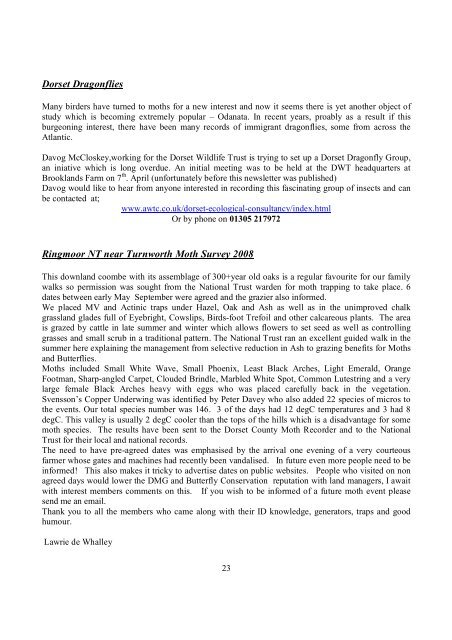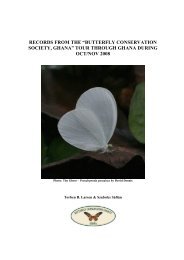newsletter 21.pdf - Dorset Moth Group
newsletter 21.pdf - Dorset Moth Group
newsletter 21.pdf - Dorset Moth Group
Create successful ePaper yourself
Turn your PDF publications into a flip-book with our unique Google optimized e-Paper software.
<strong>Dorset</strong> Dragonflies<br />
Many birders have turned to moths for a new interest and now it seems there is yet another object of<br />
study which is becoming extremely popular – Odanata. In recent years, proably as a result if this<br />
burgeoning interest, there have been many records of immigrant dragonflies, some from across the<br />
Atlantic.<br />
Davog McCloskey,working for the <strong>Dorset</strong> Wildlife Trust is trying to set up a <strong>Dorset</strong> Dragonfly <strong>Group</strong>,<br />
an iniative which is long overdue. An initial meeting was to be held at the DWT headquarters at<br />
Brooklands Farm on 7 th . April (unfortunately before this <strong>newsletter</strong> was published)<br />
Davog would like to hear from anyone interested in recording this fascinating group of insects and can<br />
be contacted at;<br />
www.awtc.co.uk/dorset-ecological-consultancy/index.html<br />
Or by phone on 01305 217972<br />
Ringmoor NT near Turnworth <strong>Moth</strong> Survey 2008<br />
This downland coombe with its assemblage of 300+year old oaks is a regular favourite for our family<br />
walks so permission was sought from the National Trust warden for moth trapping to take place. 6<br />
dates between early May September were agreed and the grazier also informed.<br />
We placed MV and Actinic traps under Hazel, Oak and Ash as well as in the unimproved chalk<br />
grassland glades full of Eyebright, Cowslips, Birds-foot Trefoil and other calcareous plants. The area<br />
is grazed by cattle in late summer and winter which allows flowers to set seed as well as controlling<br />
grasses and small scrub in a traditional pattern. The National Trust ran an excellent guided walk in the<br />
summer here explaining the management from selective reduction in Ash to grazing benefits for <strong>Moth</strong>s<br />
and Butterflies.<br />
<strong>Moth</strong>s included Small White Wave, Small Phoenix, Least Black Arches, Light Emerald, Orange<br />
Footman, Sharp-angled Carpet, Clouded Brindle, Marbled White Spot, Common Lutestring and a very<br />
large female Black Arches heavy with eggs who was placed carefully back in the vegetation.<br />
Svensson’s Copper Underwing was identified by Peter Davey who also added 22 species of micros to<br />
the events. Our total species number was 146. 3 of the days had 12 degC temperatures and 3 had 8<br />
degC. This valley is usually 2 degC cooler than the tops of the hills which is a disadvantage for some<br />
moth species. The results have been sent to the <strong>Dorset</strong> County <strong>Moth</strong> Recorder and to the National<br />
Trust for their local and national records.<br />
The need to have pre-agreed dates was emphasised by the arrival one evening of a very courteous<br />
farmer whose gates and machines had recently been vandalised. In future even more people need to be<br />
informed! This also makes it tricky to advertise dates on public websites. People who visited on non<br />
agreed days would lower the DMG and Butterfly Conservation reputation with land managers, I await<br />
with interest members comments on this. If you wish to be informed of a future moth event please<br />
send me an email.<br />
Thank you to all the members who came along with their ID knowledge, generators, traps and good<br />
humour.<br />
Lawrie de Whalley<br />
23



